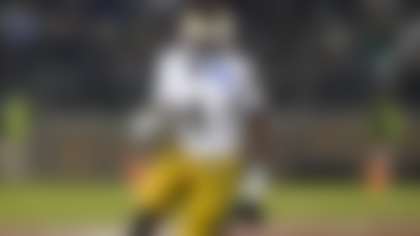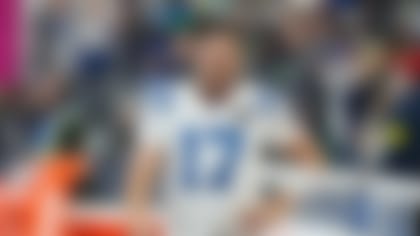FOXBOROUGH, Mass. - Three trades. Two youngsters added to a group of old running backs. One potential successor to Tom Brady.
And no pass rushers.
The New England Patriots stuck to their traditional draft strategy on Friday -- focusing on their ratings of players and not their positions of need and stocking up on draft choices.
They added picks in the first and second rounds next year in the first two days of the draft. But they didn't address the need for an improved pass rush. They finished 14th in the NFL last year with 36 sacks.
Carucci: Blessing in disguise?
Ryan Mallett landed with the one coach who could do plenty to help him to overcome the negatives that led to his fall into the third round, Vic Carucci writes. **More ...**
Watch
»
QB the perfect fit?
»
Belichick on Mallett
Coach Bill Belichick hopes that can get better with help from outside linebacker Jermaine Cunningham, who had one sack as a rookie last year, and others who are still progressing.
"Younger players will still continue to develop at every position," he said.
That's especially important at running back, where he has 34-year-old Kevin Faulk, who spent most of last season on injured reserve, 34-year-old Sammy Morris and 35-year-old Fred Taylor. That leaves BenJarvus Green-Ellis, 25, and Danny Woodhead, 26.
So the Patriots drafted running backs Shane Vereen of California in the second round and Stevan Ridley of LSU in the third.
They also went for strong-armed Ryan Mallett, a 6-foot-6 quarterback from Arkansas, in the third round and cornerback Ras-I Dowling of Virginia with the first pick of the second.
The Patriots made two trades Friday. They sent the 28th pick of the second round to Houston for the ninth pick of the third round and the 10th of the fifth. Then they traded the 28th choice of the third round and eighth selection of the fourth to Oakland for the 16th pick of the seventh round and a second-rounder next year. A deal with New Orleans on Thursday brought a first-round pick next year.
On Saturday, they have no picks in the fourth round, two in the fifth and one in each the sixth and seventh.
The 6-1 Dowling joins 5-10 Devin McCourty, a first-round pick last year, in the cornerback group, along with 6-1 Leigh Bodden, Darius Butler and Kyle Arrington.
Size, Belichick said, is an asset with so many tall receivers in the NFL.
"It seems like every week we're going against big, physical receivers," he said. "Being able to tackle, being able to be physical being able to jam guys" are significant skills for cornerbacks.
Dowling started only two of the five games he played as a senior before his season ended when he fractured his left ankle. He also suffered knee and hamstring injuries last season.
"I'm feeling great," he said. "I'm 100 percent. If we had camp tomorrow, I'd be ready to go."
Mallett played 11 games as a freshman at Michigan -- Brady's school -- before transferring to Arkansas when new coach Rich Rodriguez brought in an offense not suited to the pocket passer.
At 238 pounds, he's tough to bring down -- but also not very elusive. And with Brady still at the top of his game, the selection of Mallett seems somewhat curious. Then again, when Brady suffered a season-ending knee injury in the 2008 opener, the Patriots relied on backup Matt Cassel the rest of the season.
"I don't think you can have too much depth at that position. We've all seen what happens," Belichick said.
At Arkansas' pro day in March, Mallett said that he didn't feel ambushed by questions at the NFL combine in Indianapolis about rumors of drug use.
"It's in the past, and I'm looking in the future," he said Friday night. "Mislabeled? If that's what you want to call it, fine. I think I was portrayed in a different light than the people that know me."
In one season at Michigan and two at Arkansas, Mallett threw for 69 touchdowns and 24 interceptions.
The Patriots had only Brian Hoyer as a backup quarterback last year, so the addition of Mallett could give Belichick an option if Brady, who underwent surgery Jan. 20 for a stress fracture in his right foot, is injured again.
"I feel good," Brady said at a promotional appearance Friday in New York. "I feel like anybody who has had surgery and had to go through rehabilitation. We still got a long time until football season starts, and I'm just working my way back."
Someday Brady's career will end. Can Mallett be his successor?
"I don't know," Belichick said. "(He'll) come in, and (we'll) let him compete."
The running backs of the future could be Vereen, a quicker, third-down style back, and Ridley, a bigger rusher who is most effective running inside.
"They're very different players," Belichick said.
Vereen started 19 games in three years, running for 2,834 yards for 29 touchdowns on 556 carries, an average of 5.1 yards per rush.
"I always take pride in myself in being able to do all things that are called on for a running back: catching the ball, pass protection, running the ball," he said.
Ridley started only nine games in college but was LSU's primary back last season when he gained 1,147 yards with 15 touchdowns on 249 carries, an average of 4.61 yards per run.
"He's a bigger, physical back," Belichick said. "Good running style. Gets a lot of tough yards."
He could run behind Nate Solder, the left tackle from Colorado taken by the Patriots in Thursday's first round. He figures to be the starting left tackle of the future, which may not be far off with Matt Light's current free agency.
"It's a huge responsibility, protecting the quarterback, being able to run the ball," he said Friday on a visit to Gillette Stadium. "That's something that I always loved. I always love a challenge."
Copyright 2011 by The Associated Press



